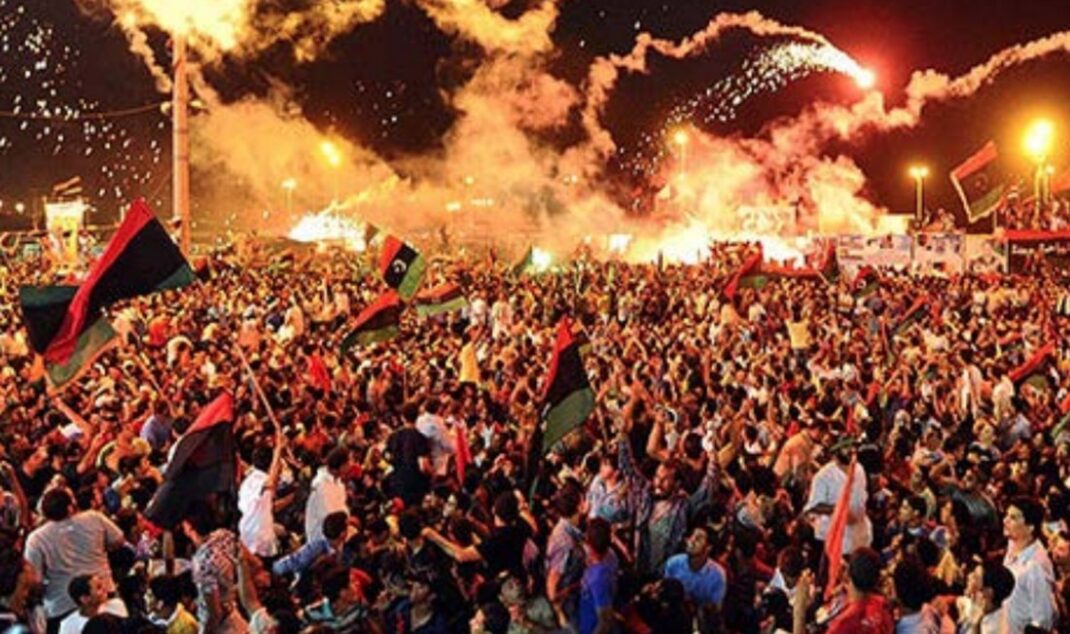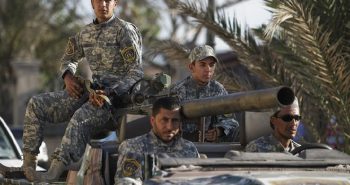Editors: Nadja Berghoff and Anas El-Gomati

 A decade on from the February 17th revolution, how the global disorder transformed Libya into a battleground for interest, ideology and influence.
A decade on from the February 17th revolution, how the global disorder transformed Libya into a battleground for interest, ideology and influence.
Chapter 12
United Arab Emirates: Reversing the Revolution
By Matthew Hedges
 At surface level, Libya’s relationship with the United Arab Emirates (UAE) was unremarkable during the 42 years of Muammar Gaddafi’s regime.
At surface level, Libya’s relationship with the United Arab Emirates (UAE) was unremarkable during the 42 years of Muammar Gaddafi’s regime.
In late December 2010, economic ties were strengthened after Tripoli and Abu Dhabi signed an $11 billion dollars investment deal to overhaul Libya’s failing critical infrastructure.
Below the surface, much of the Gaddafi family’s private wealth – subject of United Nations investigations – is believed to have been discretely stashed in banks across the world, with an estimated $50 Billion dollars of dark money in the UAE alone.
These economic ties would become little more than a footnote with the onset of the Arab Spring in early 2011 as Libya became the platform of the UAE’s extraordinary transformation into one of the most assertive actors in the region.
The UAE had sat back and watched the revolution unfold in Tunisia, but by the time protests had reached Egypt in January 2011, and were endorsed by the United States (US), Abu Dhabi became alarmed at the unfolding events and their potential to reshape the wider regional order.
According to former US President Barack Obama, the UAE’s de facto ruler Crown Prince Mohamed Bin Zayed (MBZ) warned him of supporting the Arab Spring, claiming that if Mubarak fell the Muslim Brotherhood would take over and “eight other Arab leaders would fall”.
As a result, the Arab Spring’s third theatre in Libya rapidly grew in importance and developed into the frontline of Abu Dhabi’s new counterrevolutionary engagement.
The infectious revolutions were perceived by elites in Abu Dhabi as an existential threat to regime security, and the UAE’s foreign policy towards Libya offered an opportunity to not only shape its outcome, but inoculate itself in the process.
The revolution
In 2011, the opportunity to remove Gaddafi was energised by the international community’s call to arms under United Nations Security Council resolution 1973 and NATO’s Operation Unified Protector (OUP).
To Abu Dhabi, this mission presented a favourable proposition to demonstrate its military capabilities while buying influence not just with Western partners but with revolutionaries on the ground.
The UAE had already engaged with NATO and its allies in Afghanistan, however in Libya it contributed to combat operations by establishing relationships on the ground and helped enforce the no-fly zone over the skies.
Despite initial issues integrating its airpower component into NATO’s operation, the UAE’s Special Forces operations on the ground in Libya alongside Qatari Special Forces operations provided an important support tool to the alliance.
Their training and equip missions merged local rebel groups into a coherent fighting force that would ultimately topple the Gaddafi regime in August 2011.
While the UAE’s engagement in Libya seemed to have started in good faith, it was merely exploiting NATO’s platform of internationally sanctioned legitimacy and influence to construct its own long-term project for a future Libya; one which it could control, not just influence.
The aggressive and shrewd foreign policy strategy that it would pursue in the years that followed was a consequence of the UAE’s frustration to navigate Libya’s post Gaddafi transition in 2011.
Despite the UAE’s relationships with a broad range of influential political actors and powerful armed groups on the ground that toppled Gaddafi in 2011, they would find these relationships were meaningless in post-Gaddafi Libya.
The revolution had birthed a multitude of armed groups, not just the ones who toppled Gaddafi, none of whom alone could control more than small patches of turf beyond their own locale, and by consequence only offered limited influence to their patrons at best.
Libya’s first post Gaddafi democratic election of the General National Congress (GNC) in July 2012 also reset the UAE’s political influence it had acquired during the revolution.
The establishment of a new pluralist legislative institution split between 60% independent candidates and 40% political parties who would vote to appoint a new government introduced new unknown political actors who could not be so easily co-opted or controlled.
Changing gears
By 2013 Abu Dhabi would shift gears, accelerating its aggressive new regional foreign policy engagement strategy. At this juncture, the UAE’s regional partnerships became noticeably defined by ideational synergies, with an overt ‘counterterrorism’ narrative becoming the backbone of its strategic communications approach.
The goal was to reinforce the perception of the Arab Spring as a vehicle for Islamists widely framed by Abu Dhabi as ‘terrorists’ to take control of the region; and by consequence rebrand authoritarian regimes and institutions – in particular the military – as the ‘antidote’.
This narrative not only justified authoritarian power grabs during democratic transition, but also legitimised the UAE’s muscular foreign policy tools and use of its military power to intervene should it be required.
This counterterrorism strategy was successful in Egypt where the UAE kept a light footprint in support of the 2013 military coup, but Libya would prove to be more complex. Egypt had a military, Libya did not.
The UAE’s foreign policy would require a deep strategic investment in Libya in order to overcome the political and military challenges it had faced since the overthrow of the regime.
As a result, Abu Dhabi started to back a former general in Gaddafi’s military, Khalifa Haftar. He was a figure who had drifted into obscurity following his return from exile in the US in 2011 but had re-emerged following a failed military coup attempt in Tripoli on February 14th 2011.
On May 15th, 2014, Haftar announced the establishment of the Libyan Arab Armed Forces (LAAF) and launched ‘Operation Dignity’ in Benghazi, a counter terrorism campaign supported by the UAE and Egypt through airstrikes and later by French Special Forces.
The LAAF offered the UAE the opportunity to present their campaign as the reconstruction of the military institution to fight terrorism, whilst tearing down Libya’s nascent democratic institutions.
The operation targeted Salafi Jihadist groups in Benghazi but also Libya’s first democratically elected government and parliament, and the variety of tribal and Islamist orientated armed groups loyal to it.
Abu Dhabi’s strategic relationship to General Haftar was publicly founded on the narrative of fighting ‘terrorism’; however, the application of focus developed more on political and institutional adversaries in Libya rather than the Salafi Jihadist threat.
Haftar’s LAAF was presented as a “secular” army, battling their armed and political rivals the “Islamists”. Ironically, Haftar’s LAAF included prominent Islamist groups known as Salafi Madkhalis, who had joined the LAAF following a fatwa released by a Saudi based cleric mandating their loyalty.
The operation failed and, in the process, thrust Libya into a complex civil war that divided the country into parallel competing political, economic and military institutions. The international community’s preoccupation with fighting the Islamic State in Syria meant that the UAE’s support or Haftar and strong stance on fighting ‘terrorism’ in Libya would be well received internationally.
Despite the UN’s call for a ceasefire and the establishment of the UN backed Government of National Accord in 2015, the UAE continued to support Haftar.
Incremental advances were made to expand kinetic engagement within Libya with the initial success being the capturing and control of Benghazi in 2017.
During that time the UAE developed its first overseas military facility in Eastern Libya. Military cooperation and ideational synergies with France over the fear of Islamists. It granted the UAE’s strategy in Libya and Haftar the legitimate endorsement of a permanent
member of the UN Security Council and European Union with a crucial diplomatic veto to shield it from sanction.
With advanced technology being employed, including Unmanned Aerial Vehicles (UAVs), helicopters and fighter jets Haftar had a clear strategic advantage over his opponents.
While a UN arms embargo was still in effect across Libya, the UAE whilst not acknowledging it’s role publicly, privately justified its actions to the West by arguing its military support to the LAAF was essential for countering ‘terrorism’, as opposed to preparing for a future offensive and a second power grab in Tripoli.
From this position, direct foreign military and diplomatic assistance provided Haftar with sufficient military strength to force his newly established political rivals in the GNA into a binary of negotiation or war. Following two years of diplomatic negotiations hosted by Paris and Abu Dhabi, and in parallel military encroachment into western Libya, Haftar withdrew and launched his latest assault on Tripoli on April 4th, 2019.
The battle for Tripoli: Expansion and contraction
Haftar’s latest war would have serious geopolitical repercussions in Libya. Years of Emirati coordination with Egypt, France and Russia to provide support to the LAAF in its bid to capture Tripoli and in effect Libya, neglected the rise of Turkey’s regional ambitions.
While the UAE had clearly been efficient in supporting Haftar secure Eastern Libya, Abu Dhabi and Haftar clearly required further assistance in order to move West.
Haftar’s LAAF had become deeply unstable, with tribal rifts and internal competition undermining Haftar’s authority whilst threatening its cohesion. The UAE, Russia and France’s backing of Haftar’s advance on Tripoli displayed a significant commitment to the cause and its grand strategy in Libya: this was Abu Dhabi’s moment of ascendance.
To ensure the operation’s success it secured the deployment of the Wagner Group, Moscow’s proxy mercenary force, who drafted Russian and Syrian mercenaries to fight on behalf of the LAAF in Tripoli. Meanwhile, the UAE continued to support Haftar’s offensive with aerial cover and additional deployment of Sudanese mercenaries.
What emerged was a complex network of likeminded partners of both state and non-state actors that by November 2019 saw the UAE’s proxy forces on the ground encroaching on downtown Tripoli. With the UAE’s complex network of surrogates developing an uncontrollable dynamic on its own, regional competitors felt provoked to intervene.
Turkey’s intervention not only foiled Haftar’s power grab, it transformed the geopolitical dynamics causing the United States and the European Union to reprioritize its objectives in Libya. Ankara’s decision to establish a maritime and security memorandum of understanding (MoU) sparked anger in the Eastern Mediterranean in particular with Greece and Egypt.
Abu Dhabi’s plan to forcefully unify the country under the military leadership of Haftar had failed, but for its partners it became a costly miscalculation and source of geo-political anxiety.
Future Emirati Designs
The UAE has a clear ideologically driven foreign policy strategy across the region and has pursued it with focus and determination. Its support for Haftar was discernible and bolstered by significant Egyptian, French and Russian support, but took place in a peculiar chapter in global politics.
The fact that the Trump administration had turned a blind eye to ongoing developments in Libya, meant that Abu Dhabi was able to not only pursue its foreign policy agenda in Libya but deepen its integration with Moscow in North Africa – much to the detriment of U.S. interests in the region.
The new Biden administration might take a more proactive view on Libya for this reason, forcing Abu Dhabi to at least nominally distance itself from Russia’s operations in the country.
The failure of General Haftar to secure Tripoli has blunted Abu Dhabi’s plan for the country, and despite its strategic failure in Libya, the UAE maintains a considerable investment across the country. Its military base in Eastern Libya, mercenary presence in Sirte, and its relationship to a key armed group’s leader in the capital; Haitem Tajori of the Tripoli revolutionary brigade give it strategic leverage across Libya’s vast coastline.
On the diplomatic front, the conclusion of the UN’s political process saw its main candidate Aguila Saleh fail to prize control of the Presidency following his loss to Mohamed Al Menfi. However, the UN’s unification process will conclude with an internationally recognised LAAF as part of the new Government of National Unity, and in this regard offers confidence to the UAE, and its ability to renew bilateral cooperation with its favoured institution whether Haftar remains at the helm or not.
The UAE may have lost the battle for Tripoli, but following the last round of negotiations, not the war.
***
Matthew Hedges is an academic focusing on Authoritarian regimes. He has a doctorate from Durham University where he researched the regime security strategy of the United Arab Emirates (UAE). His thesis will be published in Winter 2021 with Hurst & Co and is titled ‘Reinventing the Sheikhdom: Clan, Power and Patronage in the UAE’.
Nadja Berghoff – Programs and Communication Fellow at Sadeq Institute.
Anas El-Gomati – Director, Libya’s 1st think tank. Chief contributor Security & Governance.
____________





